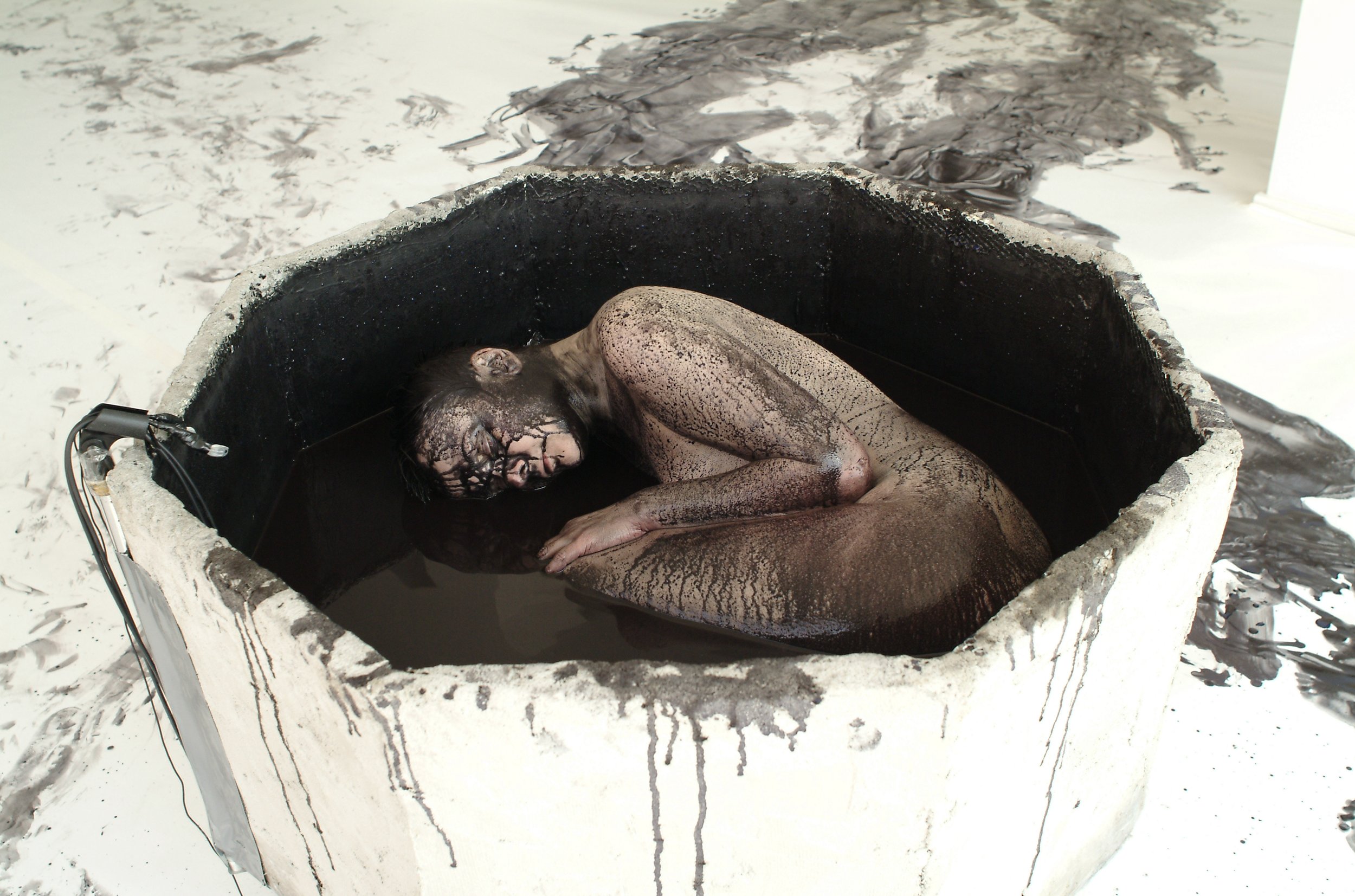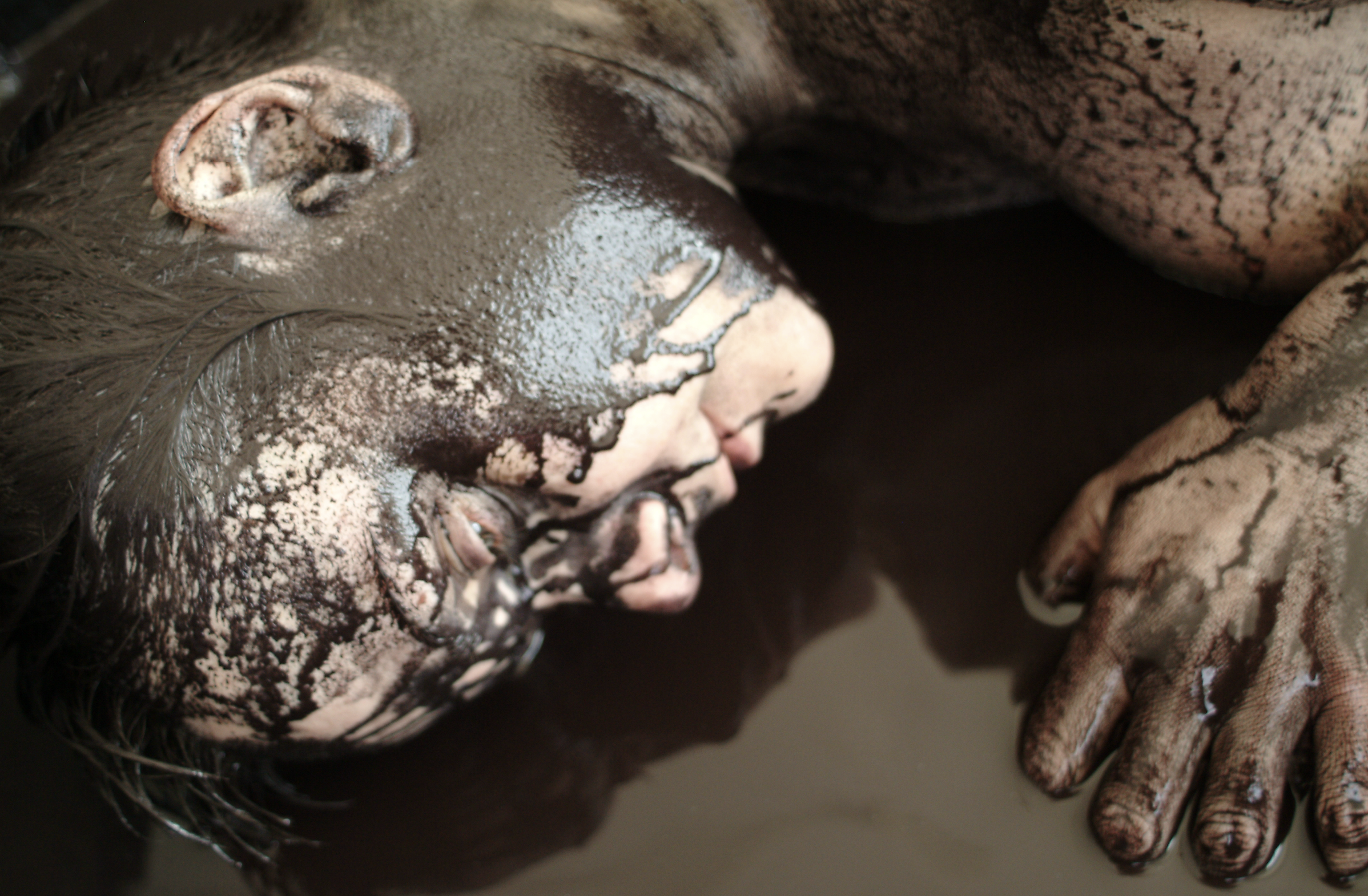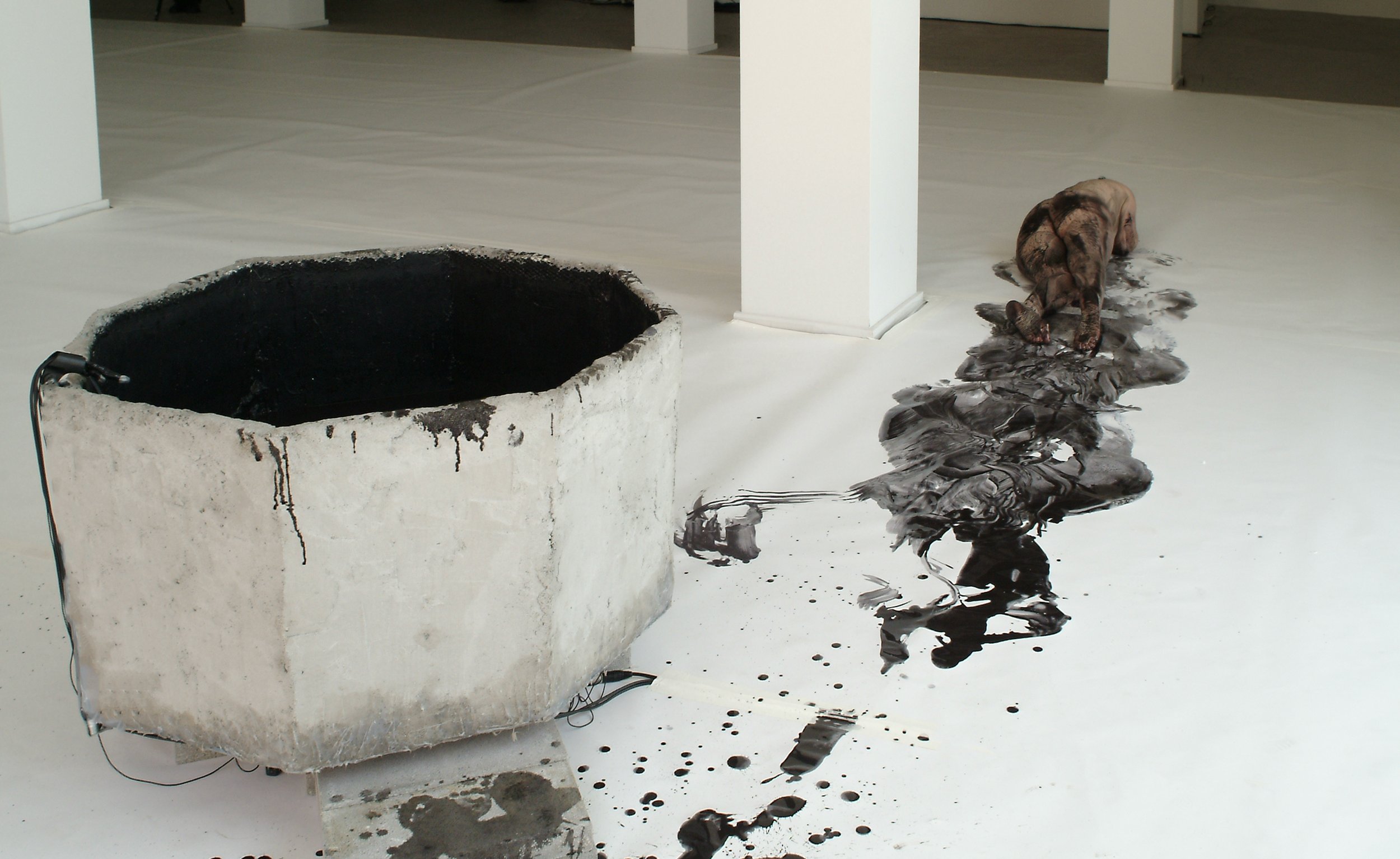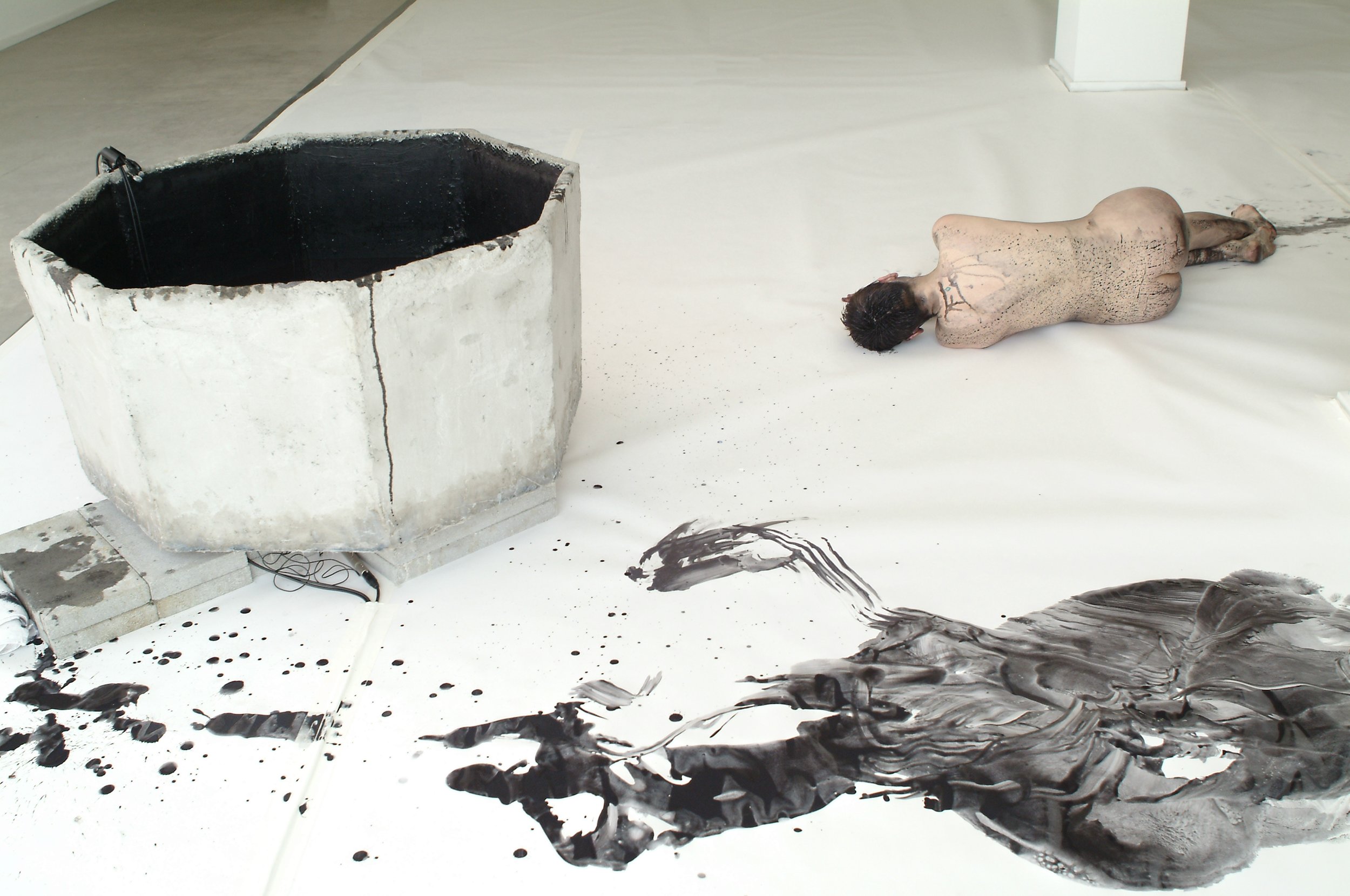Elytron
Elytron, 2003, performance based photography, c-print, dimensions variable, limited edition 3 + 2AP
Elytron (dusza i ciało to tylko dwa skrzydła)
[spirit and body are only two wings]
2003
site-specific installation: large sheets of paper cover the entire floor, a cast concrete vessel is filled with water and black ink, microphones and sound monitors emit sounds of the artist’s immersion in the vessel, filmed from above the vessel, live video footage is projected onto a wall in another part of the room
performance: the artist lies down curled up inside the sculpture, which is filled with water and black ink, she is moving slowly inside its walls emerging from time to time to leave the vessel, she moved slowly drawing through the space of the paper, leaving marks and stains, duration 6 hours
series of self-shot photography based on performance, dimensions variable, limited edition, 3 + 2AP
Elytron, 2003, performance based photography, c-print, dimensions variable, limited edition 3 + 2AP
Elytron, 2003, performance based photography, c-print, dimensions variable, limited edition 3 + 2AP
Credits
created, choreographed, designed and performed by Monika Weiss
production support: Mathew Griffin (sound technology) and Carlton Bright (video technology)
Elytron premiered as a performative installation with live sound and video projection at Chelsea Art Museum in New York [2003], as part of The Sonic Self, curated by Jolanta Góra-Wita
Artist Statement
Elytron (dusza i ciało to tylko dwa skrzydła) (spirit and body are only two wings) is a 6-hour site specific performance/installation. Moving progressively and intuitively around the floor, and using my entire figure as a metaphorical brush, I repeatedly leave and I arrive back to a sculpted vessel filled with dark fluid, until the entire canvas covering the floor becomes almost black. I leave sonic traces of the action creating a permeable, open zone of sound, while I move, curled up, within the self-imposed boundaries of canvas.
- Monika Weiss, New York, 2003
Essay Excerpts
The performance Elytron (2003) uses a cast-concrete vessel containing dyed water. When the artist crawls inside, the mass of her body displaces some of the liquid, which then makes marks wherever it spills. Although this container may signify protection and confinement, or even home, it is not neatly bounded and singular. This haphazard overflow is similar to the scattering of material in performances like Lethe Room (2005) in which a rectangular box filled with pigment-coated paper and equipped with a moving bottom is employed. When operating without the artist, the vessel's interior movement resembles slow, steady breathing. For the performance the artist inhabits the vessel and interacts with the paper. In both of these pieces the artist does not actively draw on her own body, the ink in Elytron and the red pigment in Lethe Room not only color the water and the paper, but also imprint her body, staining it like a canvas. Even long after the performance of these two works, the artist’s body continues to excrete the color through her nostrils, hair and sweat. With these two works she exceeds and cracks open the cosmos that she has constructed so it does not become stifling and airless.
This mutual imprinting of her body and the materials exemplifies the contingency of the body. Weiss’s work goes beyond constructing a self and enacting a body or an identity and works at the juncture between indexicality and intersubjectivity in Amelia Jones's terms. Weiss is not purely a performance artist because her goal is not to move to total indexicality “where the body in action simply 'is' what it presents and there is no trace left over” [Amelia Jones, Body Art: Performing the Subject]. Weiss uses her body as a tool for drawing rather than calling attention to the body itself. Weiss makes marks, videos and objects, but she does not pour, drip or fling. She inhabits, smudges and draws.
This is a distinctly female approach. Whereas Richard Serra threw lead in Splashing (1968) and Barry LeVa scattered felt in Continuous and Related Activities Discontinued by the Act of Dropping (1967), which he associated with the practice of drawing, Weiss unwittingly scatters pigment through the air, splashes fluid onto the ground and carries the marks on her body. Furthermore, Weiss’s practice is created on contingency, whether using her own body in relation to the earth, drawn marks, fluids or vessels, or setting the stage for other participants. Weiss also accomplishes this with her video editing as the disorientation of the image of the artist and/or other participants lying down can be mistaken for floating or standing. [to read full text click here]
- Katherine Carl, Monika Weiss: Drawing Cosmos in Monika Weiss-Limen II, Kentler International Drawing Space, Brooklyn, New York, 2006
Covered with black paint drawn from the dark well, she’s being baptized before our eyes as art instrument. Over and over. And the repetitive force is both ritual and conceptual, which go quite well together; ritual, after all, may be thought of as the earliest instance of proto-conceptual art.
Another part of the concept, carried by the subtitle, is taken from a nineteenth-century Polish poet, Zygmunt Krasinski: “spirit and body are only two wings.” So as we track her movements we are encouraged to see that we are only seeing half the action, the one wing as body itself. Staring won’t show us the other half. The gaze might as well subside, and move to the middle ground, to the space itself, to this gap in which we find the present action, the drawing out of the concept, the projection and bodily trajectory.
Built into this “conceptual body” is a critique of how we situate the body conceptually. Treating the body as object seems to be inevitable in our culture. Traditionally, for instance, Western anatomy is studied in the most objectified kind of body – the corpse. There is an underlying ambiguity in the very study of somatics, in that the word “soma,” which in the Greek context retained the problematic of life boundary, where the soma is also corpse, the threshold between living and dying. [to read full text click here]
- George Quasha, Conceiving Body. Remarks on the side/Elytron (spirit and body are only two wings) in Monika Weiss-Vessels, Chelsea Art Museum, New York, 2004, pp. 7 -12
Exhibitions
The Sonic Self, Chelsea Art Museum, New York, 2004, curated by Jolanta Góra-Wita
Monika Weiss - Vessels, Chelsea Art Museum, New York, 2004
Monika Weiss - Five Rivers, Lehman College Art Gallery, City University of New York, 2005-2006
Publications
Monika Weiss - Vessels, Chelsea Art Museum, New York, 2004
Monika Weiss - Limen II, Kentler International Drawing Space, Brooklyn, New York, 2006
Monika Weiss - Five Rivers, Lehman College Art Gallery, City University of New York and Galerie Samuel Lallouz, 2007
Selected Reviews + Press
Elytron, 2003, performance based photography, c-print, dimensions variable, limited edition 3 + 2AP



